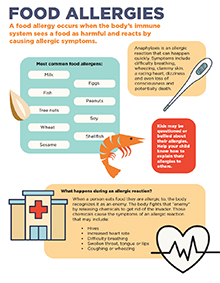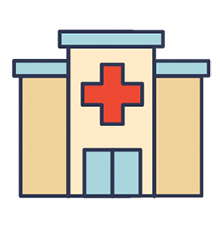Editor’s note
The following abstract describes a publication that is available as a downloadable PDF.
See the companion publication N1149, Food Allergies poster.

This handout addresses the importance of food allergy awareness and tips for managing allergies.
Topics
- Anaphylaxis shock
- Common food allergens
- Allergic reactions
- Food labels
- Cooking
- Medical ID bracelet
- Medication
- SNAP
Pages
- 2
See handout content below.
Food Allergies
A food allergy occurs when the body’s immune system sees a food as harmful and reacts by causing allergic symptoms.
Anaphylaxis is an allergic reaction that can happen quickly. Symptoms include difficulty breathing, wheezing, clammy skin, a racing heart, dizziness and even loss of consciousness and potentially death.

Most common food allergens:
- Milk
- Eggs
- Fish
- Peanuts
- Tree nuts
- Soy
- Wheat
- Shellfish
- Sesame
Kids may be questioned or bullied about their allergies. Help your child know how to explain their allergies to others.

What happens during an allergic reaction?
When a person eats food they are allergic to, the body recognizes it as an enemy. The body fights that “enemy” by releasing chemicals to get rid of the invader. Those chemicals cause the symptoms of an allergic reaction that may include:
- Hives
- Increased heart rate
- Difficulty breathing
- Swollen throat, tongue or lips
- Coughing or wheezing
Six Tips for Managing Food Allergies
Always read labels. Food labels tell us if allergens are in our food. Manufacturers can change ingredients without warning, so read every label, every time, to be sure your food is safe.
Take care when cooking. Avoid cross-contact when preparing meals at home for someone with a food allergy. Even tiny amounts of food left behind on surfaces can be enough to cause an allergic reaction. All dishes and utensils should be washed with hot, soapy water between uses.
Dine out with care. Let the manager or server know about your food allergy before you order. Ask about ingredients and food preparation to avoid cross-contact.
Have an action plan. Make a list of steps to take if you accidentally eat the food you are allergic to. Carry a printed copy with you in case someone needs to assist you.
Wear your medical ID bracelet. Make sure it lists information about your food allergy.
Always carry emergency medication. Be prepared for emergencies by always keeping medication on hand.
Funded in part by USDA SNAP.
For more information, call MU Extension’s Show Me Nutrition line at 1-888-515-0016.
Need help stretching your food dollars? Contact your local resource center or go online to mydss.mo.gov/food-assistance/food-stamp-program.